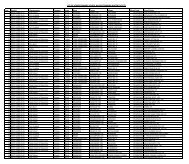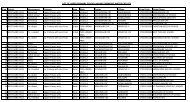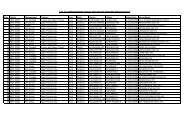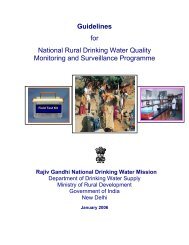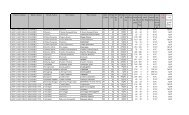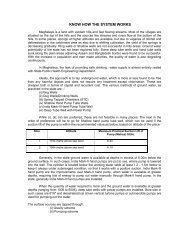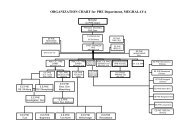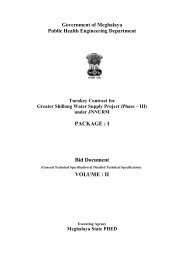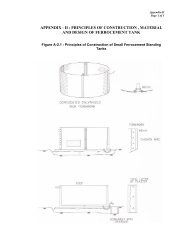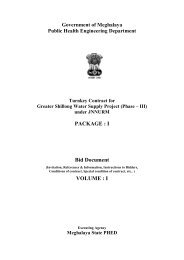PRESTRESSED CONCRETE PIPES While RCC pipes can cater to ...
PRESTRESSED CONCRETE PIPES While RCC pipes can cater to ...
PRESTRESSED CONCRETE PIPES While RCC pipes can cater to ...
Create successful ePaper yourself
Turn your PDF publications into a flip-book with our unique Google optimized e-Paper software.
Pressure Test:<br />
The field test pressure <strong>to</strong> be imposed should be not less than the greatest of the following.<br />
a) 1 1/2 times the maximum sustain operting pressure<br />
b) 1 1/2 times the maximum pipe linstatic pressure<br />
c) Sum of the maximum sustained operating pressure and the maximum surge pressure.<br />
d) Sum of the maximum pipe line static pressure and the maximum surge pessure, subject<br />
<strong>to</strong> a maximum equal <strong>to</strong> the works test pressure for any fittings incorporated.<br />
The field test pressure should whereever possible be not less than 2/3rd work test pressure<br />
appropriate <strong>to</strong> the class of pipe except in the case of spun iron <strong>pipes</strong> and should be applied and<br />
maintained for atleast four hours. If the visual inspection satisfies that there is no leakage the test<br />
<strong>can</strong> be passed.<br />
Where the fields test pressure is less than 2/3 the works test pressure, the period of test should be<br />
increased <strong>to</strong> atleast 24 hours. The test 1kg/cm2/min. If the pressure measurement are not made at<br />
the lowest point of the section an allowance should be made for the difference in static head<br />
between the lowest point and the point of measurement <strong>to</strong> ensure that the maximum pressure is<br />
not exceeded at the lowest point. If a drop in pressure is not exceeded at the lowest point. If a<br />
drop in pressure occurs the quantity of water added in order <strong>to</strong> re-establish the test pressure<br />
should be carefully measured. This should not exceed 0.1 liter per mm of pipe diameter per KM<br />
of pipe line per day for each 30 meter head of pressure applied.<br />
In case of gravity <strong>pipes</strong> maximum working pressure shall be 2/3 works test pressure.<br />
The hydrostatic test pressure at works and at field after installation and the working pressure for<br />
the difference classes of C.I Pipes are given in Appendix 6.4.<br />
The allowable leakage during the maintenance stage of <strong>pipes</strong> carefully laid and well tested<br />
during construction, however should not exceed.<br />
qL=ND \/P<br />
-------<br />
115 (6.11)<br />
where,<br />
qL = Allowable leakage in cm3/ hour<br />
N = No of joints in the length of pipe line<br />
D = Diameter in mm<br />
P = the average test pressure during the leakage test in kg/cm2.<br />
Where any test of pipe laid indicates leakage greater than the specified as per the above formula,<br />
the defective pipe (s) or joint(s) shall be repaired/ replaced until the leakage is with in the<br />
specified allowance.<br />
The above is applicable <strong>to</strong> spigot and socket Cast Iron <strong>pipes</strong> and A.C pressure <strong>pipes</strong> whereas<br />
twice this figure may be taken for steel and prestressed concrete <strong>pipes</strong>



